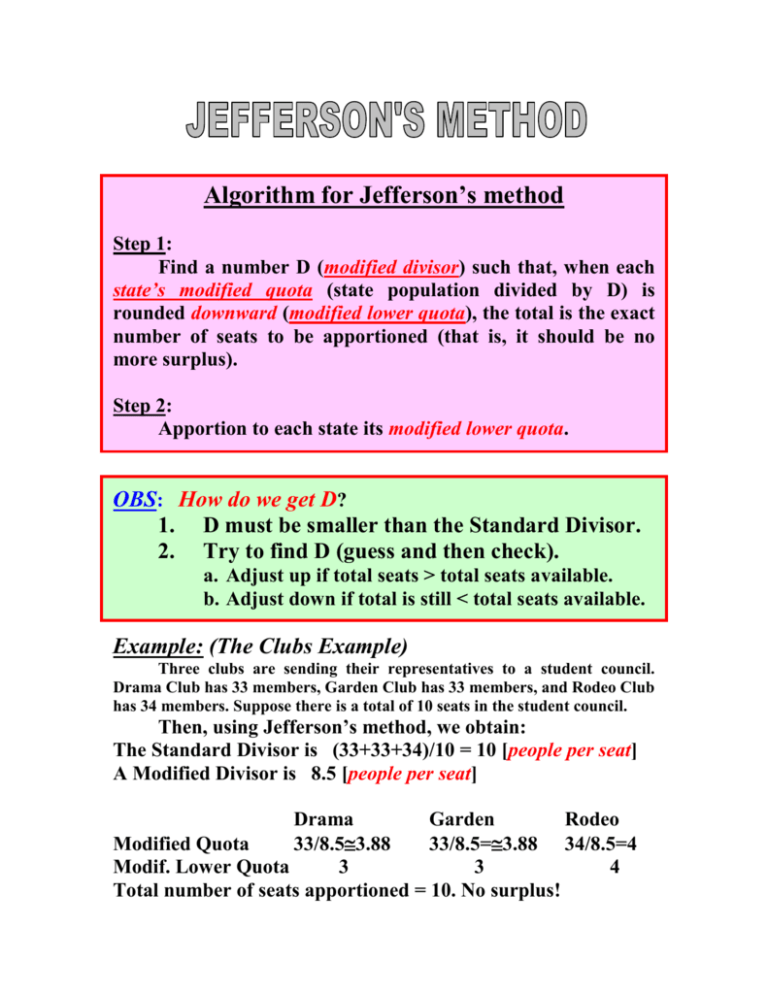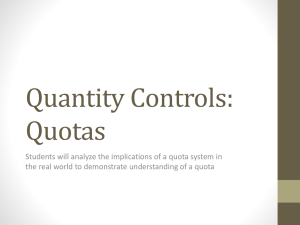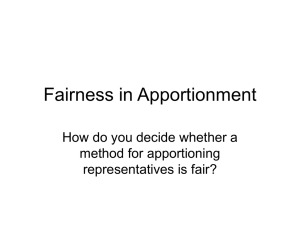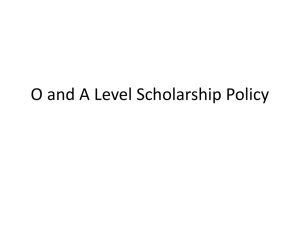Jefferson`s Method, The Quota Rule, Adams` Method, Webster`s
advertisement

Algorithm for Jefferson’s method Step 1: Find a number D (modified divisor) such that, when each state’s modified quota (state population divided by D) is rounded downward (modified lower quota), the total is the exact number of seats to be apportioned (that is, it should be no more surplus). Step 2: Apportion to each state its modified lower quota. OBS: How do we get D? 1. D must be smaller than the Standard Divisor. 2. Try to find D (guess and then check). a. Adjust up if total seats > total seats available. b. Adjust down if total is still < total seats available. Example: (The Clubs Example) Three clubs are sending their representatives to a student council. Drama Club has 33 members, Garden Club has 33 members, and Rodeo Club has 34 members. Suppose there is a total of 10 seats in the student council. Then, using Jefferson’s method, we obtain: The Standard Divisor is (33+33+34)/10 = 10 [people per seat] A Modified Divisor is 8.5 [people per seat] Drama Garden Rodeo Modified Quota 33/8.53.88 33/8.5=3.88 34/8.5=4 Modif. Lower Quota 3 3 4 Total number of seats apportioned = 10. No surplus! Example 1: There are 15 scholarships to be apportioned among 231 English majors, 502 History majors, and 355 Psychology majors. Use Jefferson’s Method to do the apportionment. Total students: 231 + 502 + 355 = 1088 Standard Divisor = 1088/15 = 72.53 Standard quotas: English: 231/72.53 = 3.185 Lower quota = 3 History: 502/72.53 = 6.921 Lower quota = 6 Psych: 355/72.53 = 4.895 Lower quota = 4 Total = 13 (2 surplus) Jefferson’s Method: need a modified quota (D). (Note: dividing by a smaller number gets a bigger quota.) Try D = 72: English: 231/72 = 3.208 Lower quota = 3 History: 502/72 = 6.97 Lower quota = 6 Psych: 355/72 = 4.93 Lower quota = 4 Total = 13 (2 surplus) Try D = 71: English: 231/71 = 3.254 Lower quota = 3 History: 502/71 = 7.07 Lower quota = 7 Psych: 355/71 = 5 Lower quota = 5 Total = 15 Modified Divisor = 71 Example 1’: (Same example, but for 30 scholarships) There are 30 scholarships to be apportioned among 231 English majors, 502 History majors, and 355 Psychology majors. Use Jefferson’s Method to do the apportionment. Total students: 231 + 502 + 355 = 1088 Standard Divisor = 1088/30 = 36.2667 Standard quotas: English: 231/36.2667 = 6.369 Lower quota = 6 History: 502/36.2667 = 13.842 Lower quota = 13 Psych: 355/36.2667 = 9.7886 Lower quota = 9 Total = 28 (2 surplus) Jefferson’s Method: need a modified quota (D). (Note: dividing by a smaller number gets a bigger quota.) Try D = 35: English: 231/35 = 6.6 History: 502/35 = 14.34 Psych: 355/35 = 10.14 Modified Divisor: 35 Lower quota = 6 Lower quota = 14 Lower quota = 10 Total = 30 Example 2 (Exerc. 7 page 142): Bandana Republic consisting of 4 states: Apure, Barinas, Carabobo, and Dolores; M=160 seats in the legislature. State Pop. (in millions) A 3.31 B 2.67 C 1.33 D 0.69 Calculate the Standard Divisor Standard Divisor = (3.31 + 2.67 + 1.33 + .69)/160 = .05 Calculate the Standard Quota for each state State A B Standard Quota 3.31 2.67 .05 .05 Standard Quota 66.2 Lower Quota for each state State A Lower Quota 66 C 1.33 .05 D .69 .05 53.4 26.6 13.8 B 53 C 26 D 13 54.48 54 27.14 27 14.08 14 54.04 54 26.92 26 13.97 13 Surplus = 160 – 158 = 2 Jefferson’s Method: need a modified quota (D). Try D = .049 Modified Quota Modified Lower Quota Total = 162 – too high! 67.55 67 Try D= .0494 Modified Quota 67.004 Modified Lower Quota 67 Total = 160. No surplus! The Quota Rule: A state’s apportionment should be either its upper quota or its lower quota. DEFINITION: DEFINITION: An apportionment that guarantees that this will always happen is said to satisfy the Quota Rule. OBS: Under Jefferson’s method, Quota Rule can be violated (it turns out that under this method only upper-quota violations are possible). Example 1: (The House of Representatives, 1832) When Jefferson’s method was adopted in 1791, it was doubtful that anyone realized that it suffers for such a major flaw; certainly neither Jefferson nor Washington did. It didn’t take long for the problem to come up though. In the apportionment of 1832, New York, with a standard quota of 38.59, received 40 seats (Upper Quota violation). This horrified practically everyone except New York delegation. Example 2: See the Example 8 page 134 from the textbook. Algorithm for Adams’ method Step 1: Find a number D (modified divisor) such that, when each state’s modified quota (state population divided by D) is rounded upward (modified upper quota), the total is the exact number of seats to be apportioned (that is, it should be no more surplus). Step 2: Apportion to each state its modified upper quota. OBS: Under Adams’ method, Quota Rule can be violated (it turns out that under this method only lower-quota violations are possible). Algorithm for Webster’s method Step 1: Find a number D (modified divisor) such that, when each state’s modified quota (state population divided by D) is rounded the conventional way (to the nearest integer), the total is the exact number of seats to be apportioned (that is, it should be no more surplus). Step 2: Apportion to each state its modified quota rounded conventional way. As usual, there is a fly in the ointment: Webster’s method also violates the Quota rule. OBS: From a practical point of view, Webster’s method is considered by many experts to be the best overall apportionment method available. OBS:






